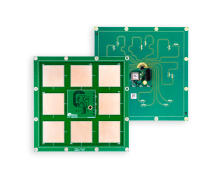
ANT-B10 antenna board
Bluetooth Low Energy 5.1 antenna board
Direction finding explorer kit with ANT-B10 antenna board and EVB-ANT-1 development platform
XPLR-AOA-3
Bluetooth 5.1 Direction Finding Explorer Kit with: u-locateEmbed software, ANT-B10 antenna board, EVB-ANT-1 development platform, and C209 tag
The XPLR-AOA-3 kit is a new addition to the XPLR-AOA product family, featuring the new generation of boards designed by u-blox for Bluetooth direction finding and indoor positioning. Users can evaluate the ANT-B10 antenna board as well as the u-blox optimized direction-finding algorithm. It also serves as a complete angle-of-arrival (AoA) anchor point reference design. The kit includes an ANT-B10 antenna board, an EVB-ANT-1 development board, and a C209 AoA tag, as well as all necessary software for operating the kit and evaluating the u-blox direction finding solution.
The ANT-B10 antenna board features an antenna array comprising eight individual patch antennas as well as the u-blox NINA-B411 Bluetooth 5.1 module. Designed for integration into commercial end-products, the board enables low power, high precision indoor positioning and speeds up evaluation, testing, and commercialization of Bluetooth direction finding and indoor positioning solutions. Using the u-locateEmbed* software, which runs on the Bluetooth module, developers can easily execute the u-blox angle calculation algorithms.
The EVB-ANT-1 application board offers developers a quick and easy way to evaluate the ANT-B10 antenna board. It features the NXP RT1061 MCU for configuring and developing direction finding applications, as well as an Ethernet PHY chip and u-blox MAYA-W1 Wi-Fi module. An off-the-shelf pin header on EVB-ANT-1 allows easy connection to ANT-B10, yielding a ready-to-use AoA indoor positioning anchor point in seconds.
The C209 is a tag based on the NINA-B406 Bluetooth LE module. It runs software that sends out Bluetooth 5.1 advertisement messages for reception by the ANT-B10 antenna board, which will then determine the direction of the tag via the u-locateEmbed* software.
The XPLR-AOA-3 kit can be used to explore many different indoor positioning applications. For example, it can detect if an object is approaching a door, keep track of goods passing through a gate, avoid collisions between automated guided vehicles, or let a camera follow an asset moving in a room. A positioning system can be created by combining several XPLR-AOA-3 kits and triangulating the directions from three or more ANT-B10 antenna boards.
* Note: u-locateEmbed was previously named u-connectLocate.